If you are playing an electric guitar, you are probably in constant search of the perfect tone, and once you find it, you will want to sound like that all the time. That is great, but reproducing the same kind of sounds and tone is going to be a challenge, because those depend on a lot of different factors, such as room ambiance or amp.
But, whether you are trying to play live or recording your work inside the studio, you are going to want to capture all of the nuances of your playing, and for that, you will need a high-quality microphone for recording your electric guitar.
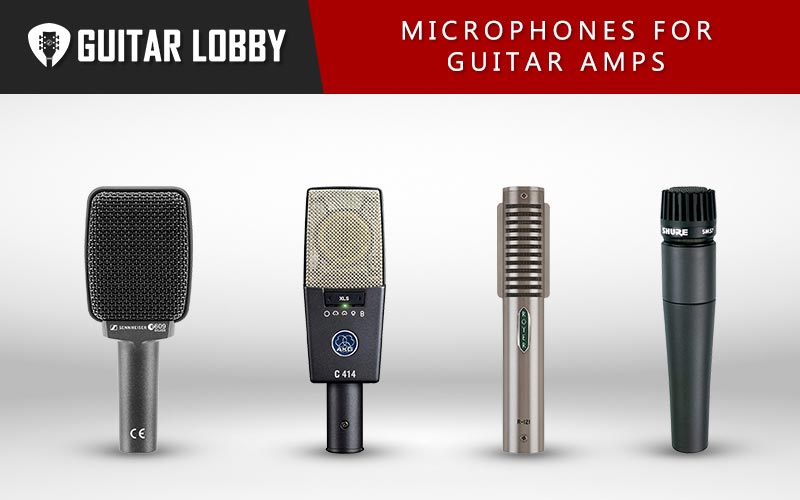
However, once you start looking into mics, you will find that it’s easier said than done. Not only are many different microphone brands out there, but there is also a seemingly endless number of specific microphones for recording your electric guitar amp.
And to make matters even more complicated is the fact that microphones can be divided into several different categories, each one often belonging to more than one. To help you make sense of all this, I’ve put together an in-depth guitar amp mic buying guide at the bottom of the page and reviewed the best mic for guitar amps at each price point below.
| Name of Product | Image of Product | Description | Price Range | Full Review |
|---|---|---|---|---|
| 1. Neumann U 87 Ai Switchable Studio Microphone (Best Overall) | 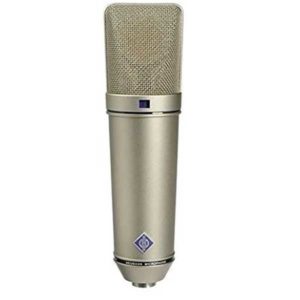 | Type: Condenser Diaphragm Size: Large | $3100 | Read Full Review Below |
| 2. Shure SM-57 Cardioid Dynamic Instrument Mic (Best Value) | 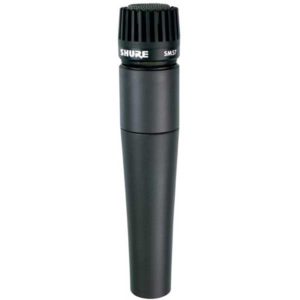 | Type: Dynamic Diaphragm Size: Small | $100 | Read Full Review Below |
| 3. Sennheiser MD 421 II Cardioid Dynamic Microphone (Best Under $500) | 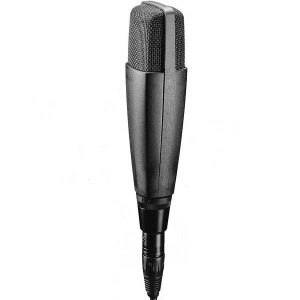 | Type: Dynamic Diaphragm Size: Large | $380 | Read Full Review Below |
| 4. Sennheiser E609 Silver Super Cardioid Instrument Microphone (Best Under $200) | 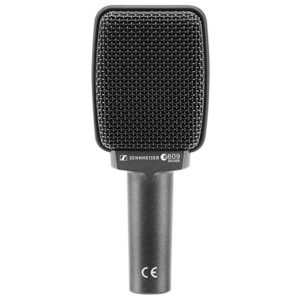 | Type: Dynamic Diaphragm Size: Large | $110 | Read Full Review Below |
| 5. sE Electronics X1 A Condenser Microphone | 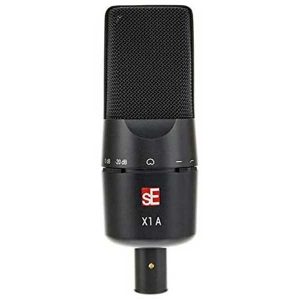 | Type: Condenser Diaphragm Size: Large | $100 | Read Full Review Below |
| 6. Royer Labs R-121 Large-Element Ribbon Microphone | 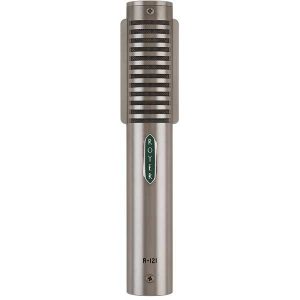 | Type: Ribbon Diaphragm Size: Not Available | $1295 | Read Full Review Below |
| 7. AKG Pro Audio C414 XLS Instrument Multipattern Condenser Microphone | 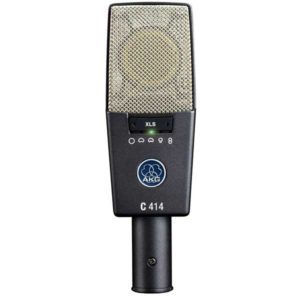 | Type: Condenser Diaphragm Size: Large | $1075 | Read Full Review Below |
| 8. Beyerdynamic M 160 Dynamic Double Ribbon Microphone | 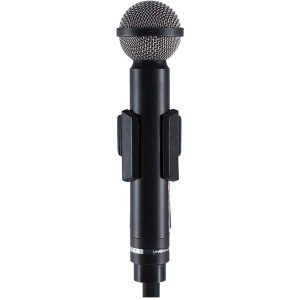 | Type: Ribbon Diaphragm Size: Not Available | $700 | Read Full Review Below |
| 9. Neumann TLM 102 Condenser Microphone | 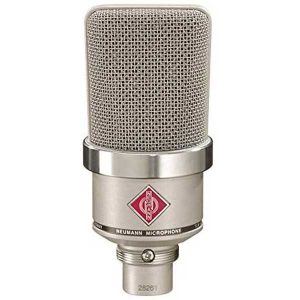 | Type: Condenser Diaphragm Size: Large | $700 | Read Full Review Below |
| 10. Rode NT4 X/Y Dual-Element Stereo Condenser Microphone | 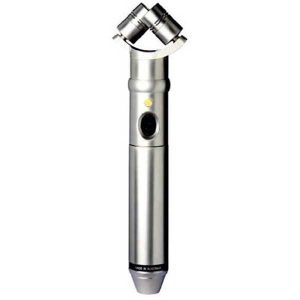 | Type: Condenser Diaphragm Size: Small | $530 | Read Full Review Below |
| 11. AKG Perception 170 Professional Instrumental Microphone | 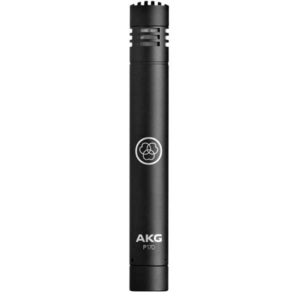 | Type: Condenser Diaphragm Size: Small | $100 | Read Full Review Below |
| 12. CAD TSM411 Supercardioid Dynamic Microphone | 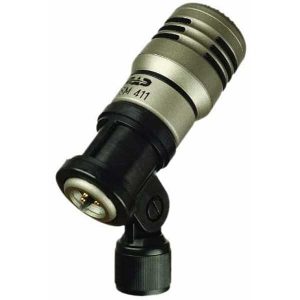 | Type: Dynamic Diaphragm Size: Not Available | $80 | Read Full Review Below |
| 13. Aston Microphones Starlight Laser-Targeting Cardioid Condenser Pencil Microphone | 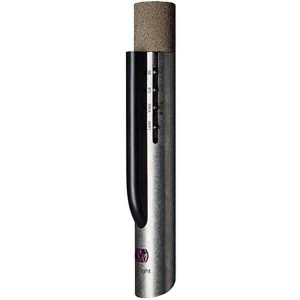 | Type: Condenser Diaphragm Size: Small | $400 | Read Full Review Below |
| 14. Sennheiser E906 Dynamic Guitar Amp Microphone | 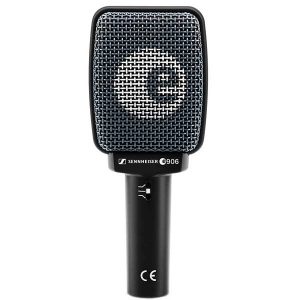 | Type: Dynamic Diaphragm Size: Large | $190 | Read Full Review Below |
Here Are the Best Microphones for Guitar Amps
1. Neumann U 87 Ai Switchable Studio Microphone (Best Overall)
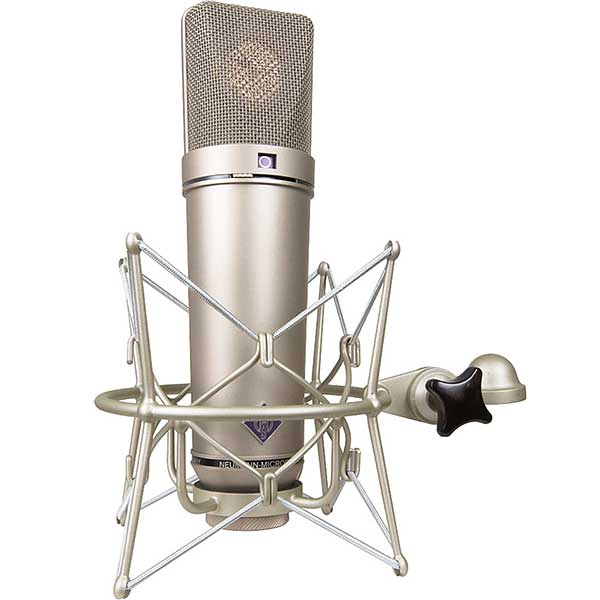
| Estimated Price | $3100 |
| Type | Condenser |
| Diaphragm Size | Large |
| Polar Pattern | Multi-Pattern |
| Frequency Response | 20Hz-20kHz |
| Max SPL | 127dB |
| Impedance | 200 Ohms |
My Review: If you are looking for the best possible microphone to record your guitar amp and money is no object, then look no further than the Neumann U 87 Ai. Not only is it the rightful successor of the legendary U 87 from the ‘60s, but it’s also a staple in most professional recording studios around the world, whether you need to record acoustic guitar, electric guitar, or vocals. The U 87 Ai is nothing less than brilliant in every situation. This is somewhat of a surprise when you take into account that dynamic microphones are usually the better choice for miking guitar amps, and U 87 Ai is a large-diaphragm condenser mic.
In fact, this is because to prevent the mic from overloading, Neumann has equipped the U 87 Ai with a 10dB attenuation switch, which we recommend you keep engaged. Another ace up U 87’s sleeve is its incredible versatility since it’s a multi-pattern microphone. This means you can choose among cardioid, omnidirectional, and Figure-8 patterns, which are guaranteed to cover just about every miking and recording situation you can think of. Since this is a condenser microphone, it requires +48V of phantom power, which is delivered through the XLR cable, which comes as standard, along with a windscreen, elastic suspension, and the mic itself inside a wooden jeweler’s box.
Who Will Use This Most: Owners of professional recording studios, recording engineers, as well as all guitarists with pockets deep enough to afford the best microphone out there. Anyone who is looking for audio perfection, regardless of price.
Bottom Line: Price aside, the Neumann U 87 Ai is almost impossible to beat. It’s build and sound quality is still unsurpassed, and its versatility leaves other mics in the dust.
2. Shure SM-57 Cardioid Dynamic Instrument Mic (Best Value)
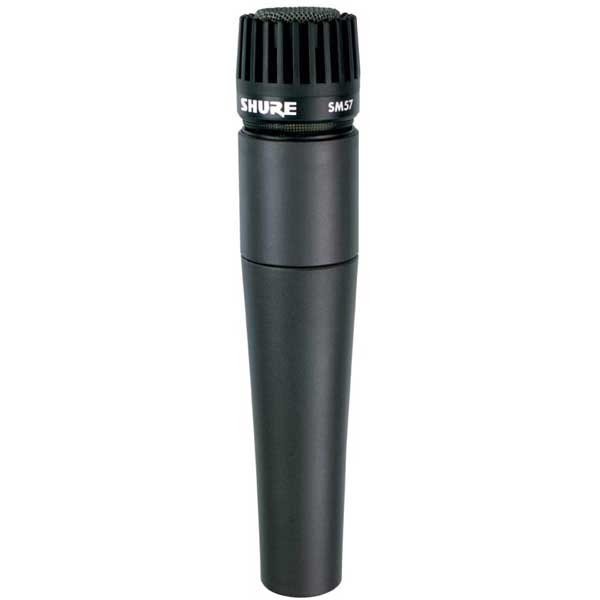
| Estimated Price | $100 |
| Type | Dynamic |
| Diaphragm Size | Small |
| Polar Pattern | Cardioid |
| Frequency Response | 40Hz-15kHz |
| Max SPL | 94dB |
| Impedance | 150 Ohms |
My Review: Another microphone that has been around since the ‘60s, and just like the U 87 Ai, the Shure SM-57 remains the golden standard for guitar amp recording and miking. In fact, you wouldn’t be able to find any mic in existence that has recorded as much electric guitar as the Shure SM-57 or which has been as widely used on stages across the globe. This could have easily ended up as our top choice, but we wanted to single it out here because of its great value. But, don’t think for even a moment that it’s cheaply made, because this thing is tough as nails and can pretty much withstand any kind of abuse and sound pressure level you can throw at it.
Its compact body tells you right away that it’s a small-diaphragm microphone. And because it’s a dynamic mic, it’s incredibly tough and rugged and requires no phantom power. And if you have a band or if you play multiple instruments, it’s versatile enough so that you can use it to record them as well. Shure is one of the best microphone brands out there, and one of the reasons why their reputation is so stellar is because of mics like the SM-57. It’s well-made, compact, and can capture just about everything you want it to, both live and inside the studio. It’s a true powerhouse of a microphone, and affordable too.
Who Will Use This Most: Because of its price and quality, it will appeal to pretty much everyone, from amateurs to professionals, which probably already have at least one of these in their arsenal. The SM-57 enables even those with a tighter budget to purchase a pair of these and try their hand at stereo recording.
Bottom Line: The Shure SM-57 is an absolute workhorse of a microphone, and regardless of what kind of guitar amp you have, it will capture its sound in all of its glory, every single time. In terms of value, this is the best microphone for guitar amps out there in my opinion. That said if your budget allows there are better amps that we’ll cover on this list.
3. Sennheiser MD 421 II Cardioid Dynamic Microphone (Best Under $500)
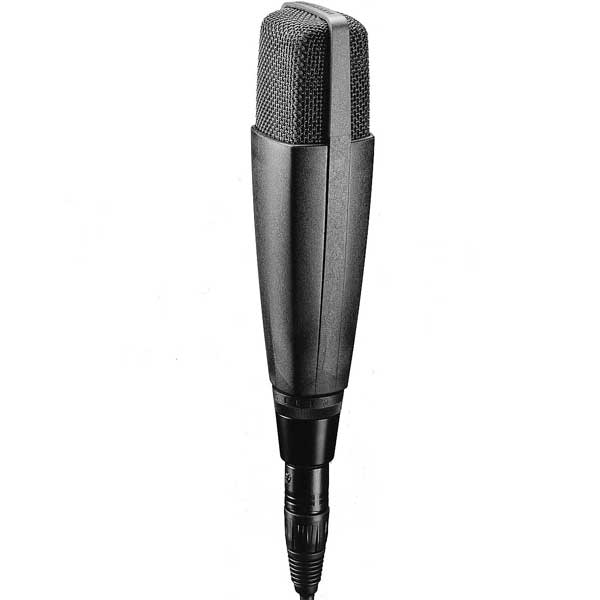
| Estimated Price | $380 |
| Type | Dynamic |
| Diaphragm Size | Large |
| Polar Pattern | Cardioid |
| Frequency Response | 30Hz-17kHz |
| Max SPL | 160 dB |
| Impedance | 200 Ohms |
My Review: Just like the Neumann U 87 Ai, the Sennheiser MD 421 II is the successor of a mic that has been around for decades, the MD 421, which is one of the most beloved mics among recording engineers. The MD 421 II picks up right where the original left off and is every bit as tough as we were expecting it to be. Because of the large diaphragm, this microphone will capture the sound of your guitar amp along with some ambiance, which will make your guitar lines sound massive. But, because it has a cardioid pickup pattern, it can isolate your instrument, so that you get a smooth, crisp sound.
The mic itself is built out of metal, and because it’s a dynamic microphone, it can handle loud amps both inside the studio and on stage, since it’s resistant to humidity, scratches, and dust. One of the reasons why you might choose it over the Shure SM-57, which is cheaper several times over, is because it has a wider frequency response, which makes for a deeper low end and brighter high end. It’s quite simply one of the best microphones you can buy today if you want to record your guitar amp.
Who Will Use This Most: Even though it’s not the cheapest mic out there, it’s still affordable enough so that your average musician can eventually purchase it, and because of its superb characteristics, it will be just as appealing to the professionals.
Bottom Line: The Sennheiser MD 421 II dynamic microphone is a terrific guitar amp mic. It’s sturdy, well-made, and coupled with the fact that it can handle any kind of SPL, the MD 421 II is hard to beat. Overall, I would say that this is the best mic for guitar amps under $500.
4. Sennheiser E609 Silver Super Cardioid Microphone (Best Under $200)
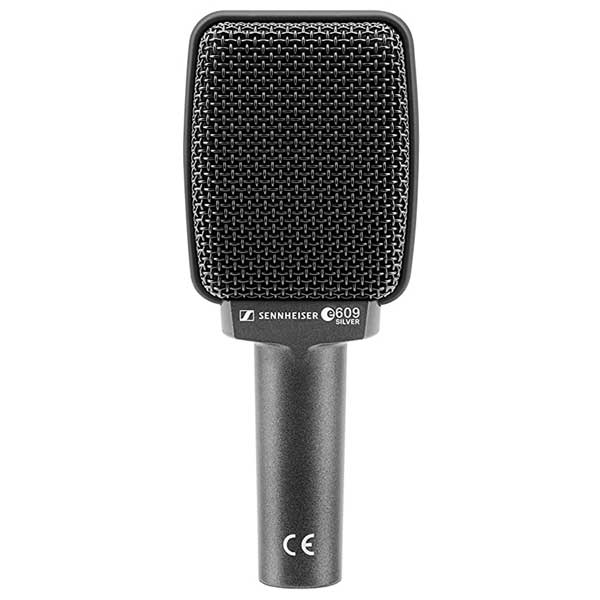
| Estimated Price | $110 |
| Type | Dynamic |
| Diaphragm Size | Large |
| Polar Pattern | Supercardioid |
| Frequency Response | 40Hz-18kHz |
| Max SPL | 160dB |
| Impedance | 350 Ohms |
My Review: The Sennheiser E609 is one of the most popular guitar amp mics around, and all those stellar reviews and glowing recommendations are there for a reason. It’s spectacular. Unlike some of the mics on this list, which strive for versatility, the E609 was designed to do one specific thing, which is to be a guitar amp mic, and it does that like no other. One of the coolest things about this mic is its flat-face design, which allows you to get really close to the amp. In fact, if you search the web for images of the E609, you will probably find a ton where this mic is hanging by its cable right in front of the amp.
This is especially useful on stage, where you don’t have to worry that you will knock over its stand or anything. And it works brilliantly in a live setting, because of the very high maximum SPL, and the fact that it’s a dynamic mic. Another advantage is its super-cardioid pickup pattern, which is very resistant to feedback and is very capable of isolating just the sound of your amp from the stage noise. The list of pros doesn’t just end there, because the Sennheiser E609 also has a hum-compensating coil, as well as a Neodymium magnet, that provide an additional layer of noise cancelation and make the sound very crisp and accurate. We also love the wide frequency response between 40Hz and 18kHz. And on top of everything, it’s pretty affordable, as well.
Who Will Use This Most: Because it’s so compact, lightweight, and affordable, it’s hard to imagine anyone not wanting to own at least one E609, whether they plan on using it live or inside the studio.
Bottom Line: The Sennheiser E609 is, in my opinion, the best microphone for guitar amps under $200, and with that low price tag, it’s one of the best overall purchases on the market today.
5. sE Electronics X1 A Condenser Microphone
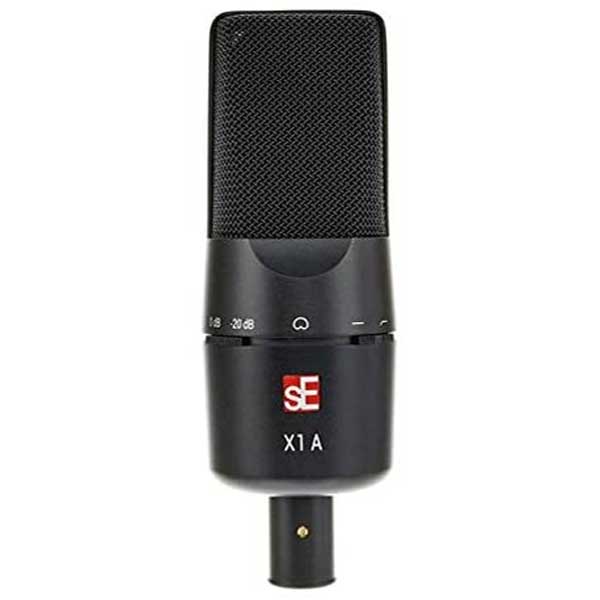
| Estimated Price | $100 |
| Type | Condenser |
| Diaphragm Size | Large |
| Polar Pattern | Cardioid |
| Frequency Response | 20Hz-20kHz |
| Max SPL | 130dB |
| Impedance | 200 Ohms |
My Review: The sE Electronics X1 A is a microphone you should definitely check out if you are operating on a tight budget, but you also want a professional-sounding recording of your guitar amp. Thanks to the high max SPL, this dynamic microphone can capture everything that’s coming out of your guitar without getting overloaded, and because there is no circuitry, there is no noise and no need for phantom power.
It also sports a -20 dB pad which enables you to lower the SPL if you are working with extremely loud amps. Thanks to the wide frequency range, the tone will sound vibrant and natural throughout the entire range. Because it’s so affordable, it’s ideal for home use, studio recording, and live performances. On top of all that, it’s incredibly tough, so you don’t have to worry about breaking it or knocking it over.
Who Will Use This Most: Everyone from beginner recording their guitar amp at home, to recording studios which would welcome it as an addition to their existing setup.
Bottom Line: The sE X1 A is a terrific mic for the price, and if you decide to buy it, you definitely won’t regret it.
6. Royer Labs R-121 Large-Element Ribbon Microphone
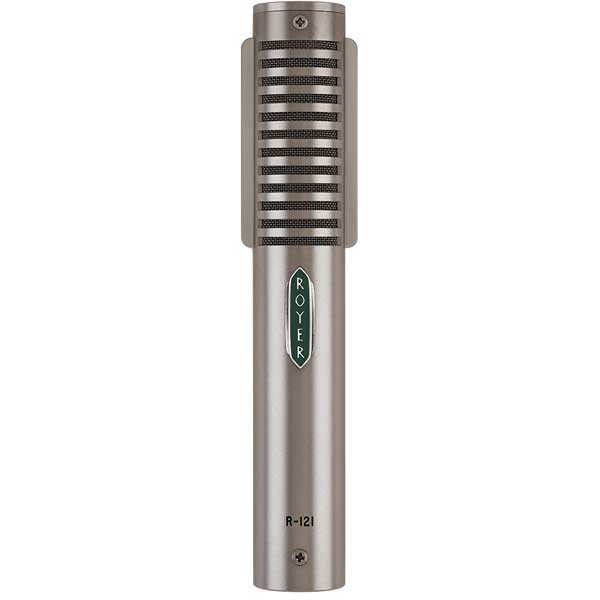
| Estimated Price | $1,295 |
| Type | Ribbon |
| Diaphragm Size | Not Available |
| Polar Pattern | Figure-8 |
| Frequency Response | 30Hz-15kHz |
| Max SPL | 135dB |
| Impedance | 300 Ohms |
My Review: If you are looking for the best sound quality and you’re willing to spend a fair bit of cash, then you definitely need to take a look at the Royer Labs 121 ribbon microphone. Although ribbon microphones have a reputation for being extremely fragile, this one is built just like any modern microphone, and able to withstand normal use. Plus, with no circuitry inside, it’s heat and humidity-resistant as well. One of the advantages of ribbon microphones is that they have an extremely high maximum SPL, and the Royer 121 is no exception.
The sound it captures is clear and accurate, free of any distortion, regardless of how loud your guitar amp is. The Royer 121 is also interesting because of the Figure-8 pattern, which makes it ideal if you want to record your amp along with some room sound. In terms of output level, this mic is right up there with the best dynamic mics, which is yet another impressive spec. This mic is also very lightweight, compact, and surprisingly tough for a ribbon microphone.
Who Will Use This Most: This microphone is already praised by professional recording engineers and guitar players alike, but because of its price, it will remain a dream for most casual players.
Bottom Line: The Royer 121 ribbon microphone is an incredible piece of gear that would be a great addition to any recording studio. Plus, it manages to eliminate some of the downsides associated with ribbon microphones. We love it, and you will too.
7. AKG Pro Audio C414 XLS Multipattern Condenser Microphone
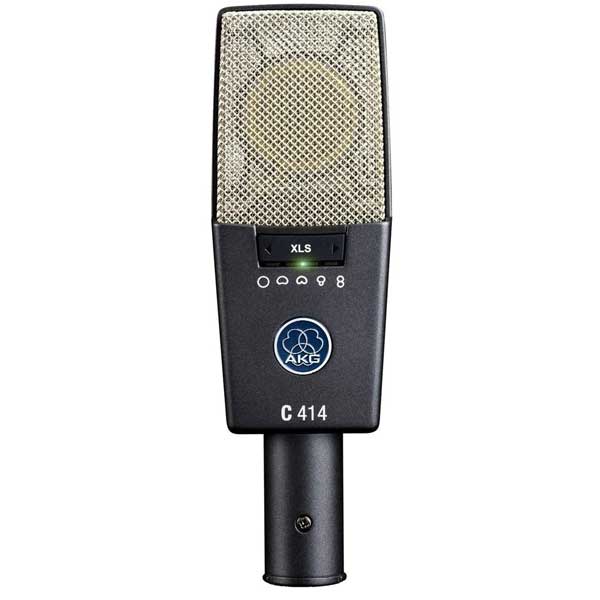
| Estimated Price | $1,075 |
| Type | Condenser |
| Diaphragm Size | Large |
| Polar Pattern | Multi-Pattern |
| Frequency Response | 20Hz-20kHz |
| Max SPL | 140dB |
| Impedance | 200 Ohms |
My Review: The AKG C4141 XLS microphone is one of the most sought-after microphones for recording guitar amps, and has been that for quite some time. If you were to walk into any professional recording studio, there is a pretty high chance that you would find one of these somewhere in there. And that’s exactly how we would best describe the C414, as a professional microphone. From build quality and sturdiness to its sound characteristic, this mic is among the best ones on the market.
The C414 is a large-diaphragm condenser microphone which is just about as versatile as it gets. Why do we say that? Well, because it allows you to choose among as many as nine different polar patterns. That pretty much gives you the ability to record not just your guitar amp, but just about every instrument you have in just about any situation or setting. Regardless of what sort of sound you are trying to mic or record, this microphone will capture it with stellar results. And because it’s a dynamic mic, you can crank up your guitar amp, without fear that you will overload the mic or end up with a sound that is distorted.
Who Will Use This Most: Since it is one of the more expensive mics around, the C414 is aimed at professional users, which means studio owners, professional guitar players, and recording artists.
Bottom Line: The Sennheiser is an iconic microphone, and its reputation is completely justified. When discussing the best microphones for guitar amps, this one should always be a part of the conversation.
8. Beyerdynamic M 160 Dynamic Double Ribbon Microphone
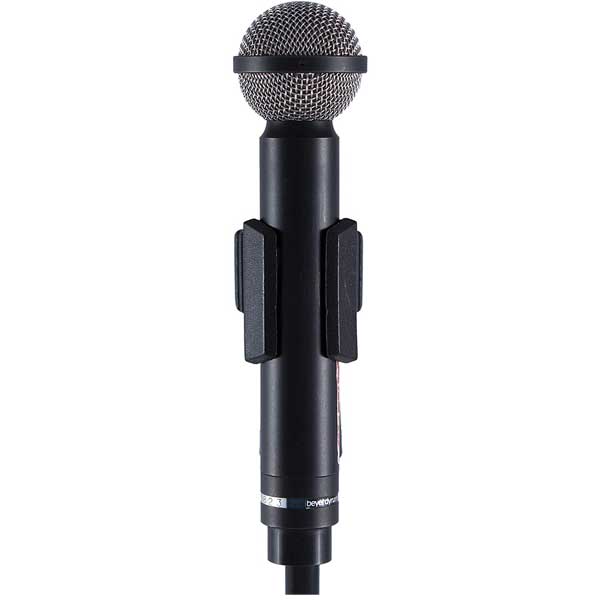
| Estimated Price | $700 |
| Type | Ribbon |
| Diaphragm Size | Not Available |
| Polar Pattern | Hypercardioid |
| Frequency Response | 40Hz-18kHz |
| Max SPL | Not Available |
| Impedance | 200 Ohms |
My Review: If the Royer 121 is too expensive for you, perhaps the Beyerdynamic M 160 might be a better option since it has nearly all of the advantages of the Royer, plus a few of its own. And it costs significantly less. Ribbon microphones are so valued among engineers and professional musicians because electric guitars sound incredible when recorded with it. In case you need any references, you will be happy to know that this mic was used to record guitar and drums tracks on legendary Led Zeppelin albums. And just like all ribbon mics, the M 160 captures a crisp but very warm and vintage-sounding guitar tone, which is making a comeback these days.
The Beyerdynamic M 160 is very compact and lightweight, which makes it very easy to position in any kind of recording situation. Unlike most ribbon mics, which are usually bidirectional with their Figure-8 pickup pattern, the M 160 sports a hypercardioid polar pattern, which makes it much easier to use and position. In addition to that, this type of pickup pattern makes this microphone very versatile, with all of the advantages ribbon mics are known for. The only downside we see with it is that it’s not as robust as the Royer 121, so you may want to predominantly use this in a studio environment.
Who Will Use This Most: Advanced guitar players which are looking to reproduce a vintage tone, as well as recording engineers. Also, guitarists which are fans of Led Zeppelin should not miss out on this one.
Bottom Line: The Beyerdynamic M 160 is a fantastic mic, especially if you prefer the sound of guitar amps from the ‘70s. But, it’s just as good for any other style of music, so check it out.
9. Neumann TLM 102 Condenser Microphone
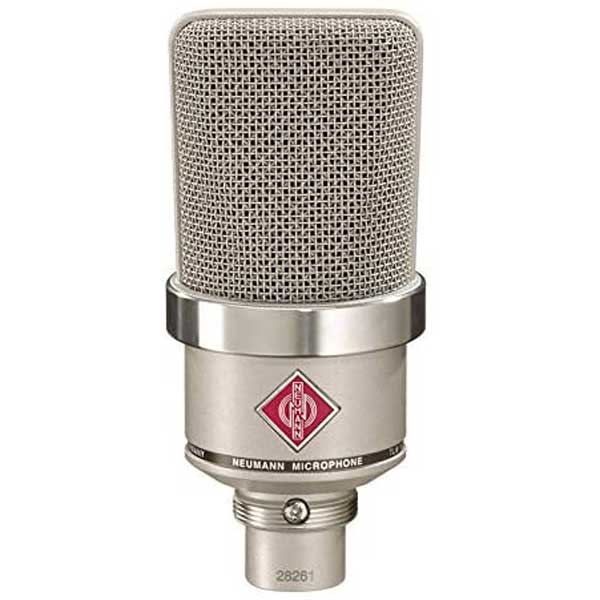
| Estimated Price | $700 |
| Type | Condenser |
| Diaphragm Size | Large |
| Polar Pattern | Cardioid |
| Frequency Response | 20Hz-20kHz |
| Max SPL | 144dB |
| Impedance | 50 Ohms |
My Review: Every microphone sporting a Neumann badge has pretty high expectations to live up to, and the Neumann TLM 102 does not disappoint. Just like all Neumanns, this is a large-diaphragm condenser microphone, but in a slightly smaller form factor. One of the reasons why this mic is on our list of best mics for guitar amps is because of the traditional Neumann build quality and craftsmanship. But, an even bigger reason is the TLM 102’s ability to handle extremely high SPLs, which is something that is usually associated with dynamic microphones. It’s pretty much unheard of that you can record a high E string on an electric guitar without any distortion to the sound.
Well, with the Neumann TLM 102, you can. Apart from handling high SPLs, the TLM 102 also has a flat frequency response and can capture clean and crisp sound across the entire sonic range. In terms of polar pattern, this is a cardioid microphone, which pretty much makes it ideal for recording your guitar amp. Although it’s not exactly affordable, it’s still among the cheapest mics Neumann has ever made, yet we couldn’t find signs of compromise in terms of sound or quality. It’s well worth the price since it’s the kind of mic you buy and keep for a lifetime, just like its big brother, the U 87 Ai.
Who Will Use This Most: Those who are looking for a high-quality condenser microphone and are willing to spend a bit more, as well as seasoned studio professionals and musicians.
Bottom Line: If you are looking for an excellent condenser mic that can capture loud sounds and high frequencies of your guitar amp without any distortion, the Neumann TLM 102 is the right choice for you.
10. Rode NT4 X/Y Dual-Element Stereo Condenser Microphone
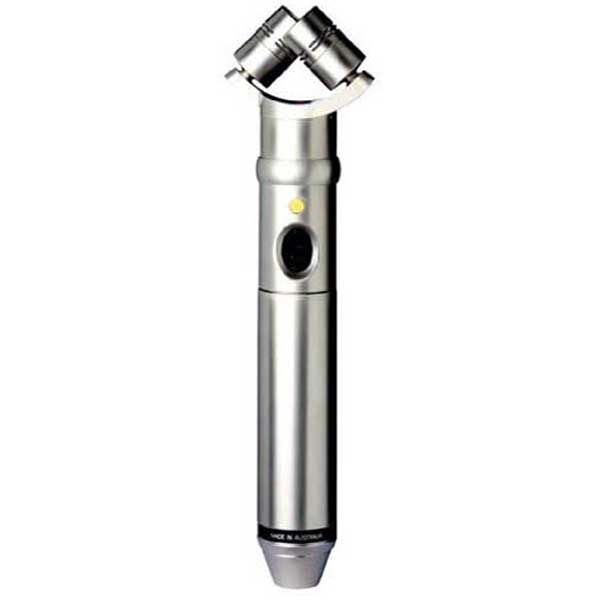
| Estimated Price | $530 |
| Type | Condenser |
| Diaphragm Size | Small |
| Polar Pattern | Cardioid |
| Frequency Response | 20Hz-20kHz |
| Max SPL | 143dB |
| Impedance | 200 Ohms per Side |
My Review: Recording a guitar amp in stereo can be a challenging endeavor, which is why most beginner guitarists shy away from it. Not only there are phasing issues you need to consider, but also the fact that you need two microphones to do it, which means you need a larger budget. On the plus side, when you record in stereo, you get a recording that is much richer and has more depth, especially if you are trying to capture some of the ambiance as well. The Rode NT4 X/Y microphone is the perfect mic for the job since it solves much of the aforementioned problems.
Despite being mounted to the same body, each mic on the NT4 has its own capsule. Because it’s a condenser microphone, you will need to provide it with phantom power when recording your guitar amp. Fortunately, you can choose between plugging it into the mixer or soundboard, or using a 9V battery. It also has a pretty high max SPL for a condenser mic, which means there is very little chance of distortion. Because of all these advantages, you no longer need to double your mono recordings, not think about positioning two different mics around your amp. The Rode NT4 makes that so much easier.
Who Will Use This Most: Musicians looking to try their hand at stereo recordings, studio professionals, as well as live performers.
Bottom Line: The Rode NT4 Dual-Element is so much more than a gimmick. It does its job really well, and it makes yours much easier. We highly recommend it.
11. AKG Perception 170 Professional Instrumental Microphone
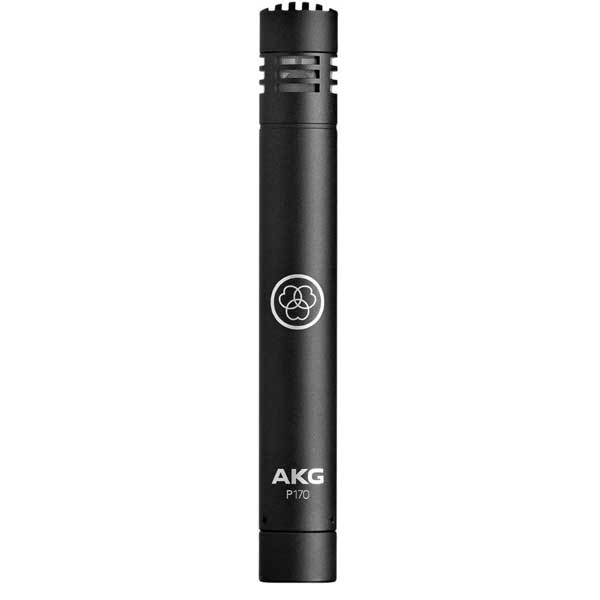
| Estimated Price | $100 |
| Type | Condenser |
| Diaphragm Size | Small |
| Polar Pattern | Cardioid |
| Frequency Response | 20Hz-20kHz |
| Max SPL | 155dB |
| Impedance | 200 Ohms |
My Review: AKG makes some great microphones, and the AKG Perception 170 is no different. What is surprising, though, is the price tag, which is just under $100. However, cheap mics do not have to be poorly made, as the Shure SM-57 has proven time and time again. One of P170’s strong suits is its ability to handle really high sound pressure levels, up to 155dB, which is pretty impressive for a condenser microphone. While not very versatile, the P170 can easily record your guitar amp, be it acoustic or electric, as well as drums. And it’s pretty much ideal for that, which is why it’s one of the most popular instrumental mics.
It’s pretty tough and sturdy when it comes to construction, so you can use both live and inside the studio. In terms of polar pattern, this mic sports a cardioid pattern, which allows it to nicely isolate the sound of your guitar amp from its surroundings. This, coupled with high SPL and rugged build, makes the P170 a great choice not just for recording guitar amps, but also a great addition to any studio setup involving a dynamic microphone.
Who Will Use This Most: Electric guitar players looking to capture the sound of their instrument without breaking the bank, as well as recording engineers and studio owners who are looking for additional mics. Ideal for beginners, too, due to its price tag.
Bottom Line: The AKG Perception 170 is tough, affordable, great for recording guitar amps, and able to withstand high SPLs. For the price, what more could you ask for? It’s easily one of the best mics for electric guitar recording.
12. CAD TSM411 Supercardioid Dynamic Microphone
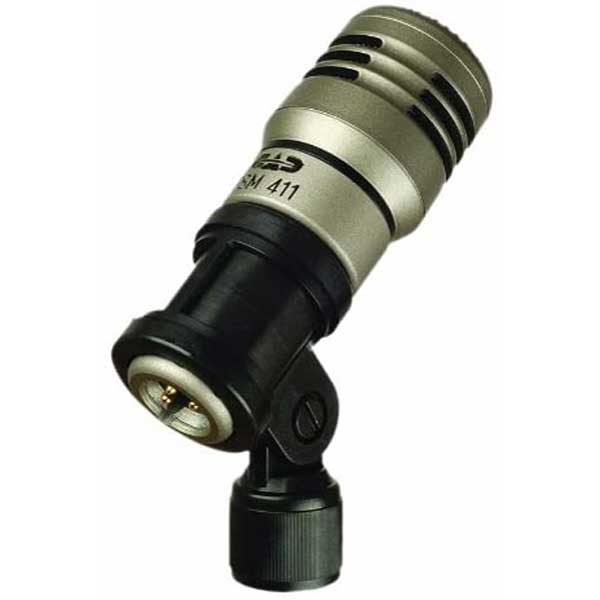
| Estimated Price | $80 |
| Type | Dynamic |
| Diaphragm Size | Not Available |
| Polar Pattern | Supercardioid |
| Frequency Response | 100Hz-15KHz |
| Max SPL | Not Available |
| Impedance | 310 Ohms |
My Review: The Shure SM-57 and the AKG P170 have shown us that mics that cost less than $100 can be not just good, but excellent. Surely you can’t go any lower than that in terms of price and still get a capable microphone for recording your guitar amp? Well, the CAD TSM411 microphone begs to differ. CAD is a brand that has been making quality microphones for years, and this particular model has been around for a decade or so. During that time, it has proven itself as really tough, reliable, well-made, and able to withstand the high SPLs, because it’s a dynamic microphone.
The body of the mic is made from die-cast metal, which makes this a tough workhorse capable of miking/recording a guitar amp inside the studio or during live performances, And because it’s a dynamic mic, you don’t have to worry about overloading it. What we like about the TSM411 is its bass response, which gives your guitar sound a big boost. However, the resulting sound is very well balanced through the entire frequency range. It’s one of the smallest dynamic mics out there, which makes it very easy to carry.
Who Will Use This Most: Pretty much everyone who is looking to record their guitar amp on budget, but without having the sacrifice sound or build quality in the process.
Bottom Line: The CAD TMS411 is a sturdy, affordable option if you are looking to record your guitar amp on a budget, but which sounds like a more expensive microphone.
13. Aston Microphones Starlight Laser-Targeting Cardioid Condenser Pencil Microphone
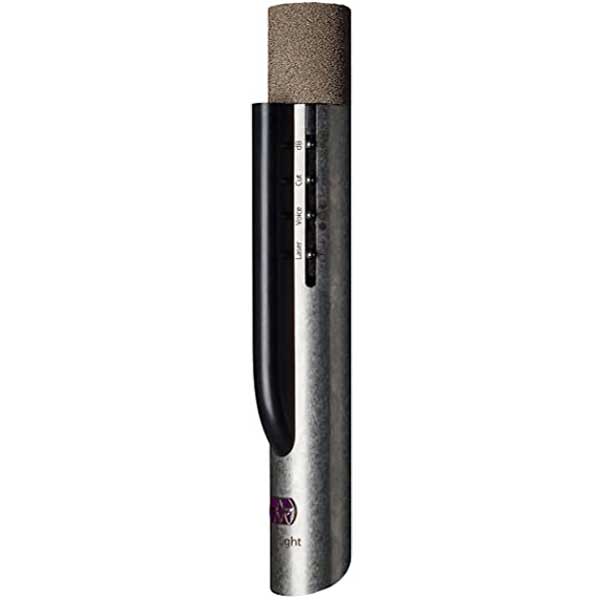
| Estimated Price | $400 |
| Type | Condenser |
| Diaphragm Size | Small |
| Polar Pattern | Cardioid |
| Frequency Response | 20Hz-20kHz |
| Max SPL | 150dB |
| Impedance | Not Available |
My Review: Aston Microphones is a company that has been around since 2015, so it’s a newcomer on the market. However, in that short amount of time, they were able to generate quite the buzz in the industry with its innovative microphones. One of those cutting-edge mics is the Aston Starlight. The innovation comes in the shape of three different voices this microphone can have: Vintage, Modern, and Hybrid. Among these three, you can always find that perfect setting for your guitar amp, as well as your playing style.
The Starlight has a few more party pieces, such as the sintered metalhead, which is something we haven’t seen yet on microphones, and which was designed to provide an ideal response. It also has a class 2 laser, which enables you to see exactly where your mic is pointing. Simply mark that spot on your guitar amp with some chalk and you will be able to position your microphone in the exact same way every single time. Cardioid pickups pattern enables you to isolate your amp, and the mic itself is built like a tank.
Who Will Use This Most: This particular mic will be very interesting to professional guitar players who need a nearly indestructible mic for live performances, as well as recording engineers who will record them in the studio.
Bottom Line: The Aston Starlight is an innovative and versatile microphone that can fulfill all of your recording needs, thanks to a combination of different voices and sturdy build.
14. Sennheiser E906 Dynamic Guitar Amp Microphone
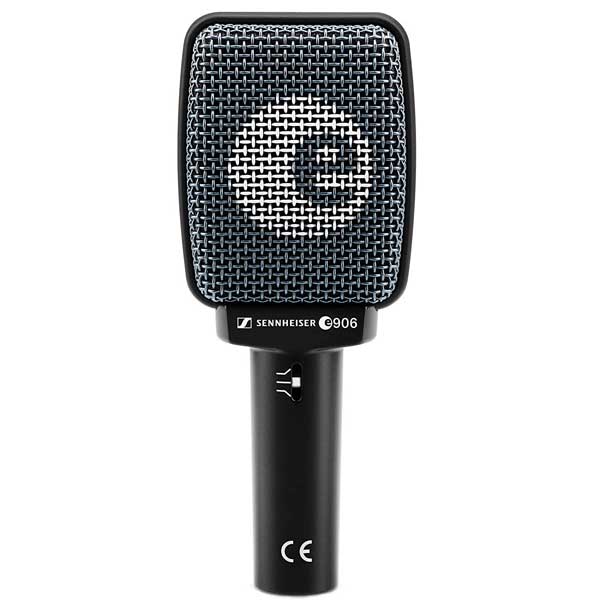
| Estimated Price | $190 |
| Type | Dynamic |
| Diaphragm Size | Large |
| Polar Pattern | Supercardioid |
| Frequency Response | 40Hz-18kHz |
| Max SPL | 160dB |
| Impedance | 350 Ohms |
My Review: This is the third Sennheiser microphone on our list, which just shows that they are one of the best microphone brands for guitar mics, and in general. The E906 is not to be confused with the E609, which is also on the list. They do share some similarities, though. First of all, there is the flat-face design, which enables you to get this microphone as close as possible to your amp, or even hang it from the amp. Another similarity is the supercardioid pattern, which allows you to capture just about every nuance of your guitar tone, without any of the surrounding noise.
The Sennheiser E906 really shines when you pair it up with a loud guitar amp or even drums. There is no distortion, and the sound is very well-balanced and natural, with plenty of detail. As you would expect from a Sennheiser, the E906 is extremely tough and well-made, and you can rest assured that it will withstand any abuse you can throw at it in a live setting, but it will also be nothing short of brilliant inside the studio. It’s easily one of the best dynamic microphones you can buy today, and it comes with a 10-year warranty.
Who Will Use This Most: Given the quality and its price, the E906 will appeal to pretty much everyone, there is no question about it.
Bottom Line: The Sennheiser is one of the best dynamic microphones if you want to record your guitar amp. We cannot recommend it enough.
Choosing a Mic for Guitar Amps (Buying Guide)
In this guide, we will try and explain everything there is to know about different mic types, how they are built, what you need to look for when buying one, as well as which type of microphone is used in which situation. We will also look into some tips and guidelines on how you should set up your mic and electric guitar amp in order to achieve the best possible guitar sound when recording your tracks. Let’s begin by explaining the difference between dynamic and condenser microphones:
Dynamic vs. Condenser Microphones
This is arguably the most important categorization among mics. Dynamic and condenser microphones differ from one another not just in their purpose, but also in the way they are constructed. Each microphone is basically a transducer, which means it is a device designed to transform one form of energy into another. In the case of microphones, we have the conversion of sound into electrical signals. Dynamic and condenser microphones perform this conversion in different ways.
Dynamic microphones are built using a mechanism made up of a diaphragm, voice coil, and a magnet. The membrane, or diaphragm, is usually made from thin plastic or polyester, and it vibrates as it captures sound waves. The voice coil, which is essentially a wire coil, is attached to the back of the membrane and it vibrates together with it inside a magnetic field which is generated by a small permanent magnet. Those of you familiar with electronics will also notice that this sort of assembly resembles a small electrical generator. It is this vibration of the coil inside the magnet that generates an electrical signal.
As you can see, dynamic microphones are pretty simple and straightforward in their construction, which makes them very sturdy, But, on top of being very rugged, they are pretty capable at capturing extremely high sound levels without any overload, which makes them ideal for recording or miking electric guitar amps or for loud and expressive vocals, such as those in rock or metal. Because they have so few components and require no additional power, they are also very resistant to unfavorable conditions, such as extremely low/high temperature or humidity.
Condenser microphones use a different assembly than that of dynamic microphones. What they have is a very thin diaphragm that is either made of metal or metal-coated plastic, which is placed in front of a backplate, which itself is either metallic or ceramic coated in metal. This sort of setup functions like a capacitor, which means it can store voltage. If the element is charged, there will be an electrical field between the diaphragm and the backplate. The diaphragm vibrates when exposed to sound waves, which changes the distance between it and the backplate, which in turn creates an electrical signal.
This type of construction also means that all condenser microphones require power in order to work. They can receive either via batteries or through phantom power, which is a term you will come across often. It simply means that the mic is receiving power from a power source that is not obviously visible. In most cases, the microphone is simply plugged into the mixer. The tradeoff with condenser microphones is that they create a certain amount of noise due to all the circuitry. This also makes them more sensitive to elements, and their maximum signal level is lower than that of dynamic microphones.
On the plus side, they have higher sensitivity and capture a more natural sound and higher frequencies. They are also better at obtaining the flat frequency response when compared to their dynamic counterparts. Last, but not least, their construction allows them to be very small. Making a choice between dynamic and condenser mics ultimately depends on the circumstances in which you want to mic or record your electric guitar amp. In a loud environment, such as a rock club or an outdoor festival, dynamic mics would work better. If it’s a theater or a concert hall with great acoustics that allow you to capture the best possible sound quality, you are better off with condenser mics.
Ribbon Microphones
This type of microphone is not all that common nowadays, mainly because of its price and fragility. Broadly speaking, ribbon microphones are dynamic microphones, but whereas dynamic mics use a membrane, ribbon mics use a thin strip of aluminum or some other metal that is placed between two magnetic poles. Since the ribbon is very sensitive, it responds to change in the velocity of air particles around it, as opposed to pressure, by creating a small charge. Because of this sensitivity, ribbon mics are excellent at capturing high-frequency sounds. They also have an outstanding dynamic range.
The downside, as we have mentioned already, is that they are very expensive and fragile, especially the vintage models. How fragile? Well, let’s just say that you could break them by exposing them to stronger airflow, or by placing them on their side. Needless to say, they work best in a controlled studio environment.
Large vs. Small Diaphragm Microphones
Another way in which microphones are categorized is according to the size of their capsule, regardless of whether they are dynamic or condenser mics. Depending on the diameter of the capsule, we can divide microphones into two types: large- and small-diaphragm mics. While there is no strict rule and there are exceptions, large diaphragms are usually 1 inch in diameter, while small diaphragms are usually ½ inch in diameter or below. This is also reflected in the design, because large-diaphragm mics are usually much bigger than small-diaphragm mics, which are usually pretty narrow and often pencil-shaped. As in the case of dynamic and condenser mics, one is not necessarily better than the other. So what’s the deal with both of these types?
Well, for instance, large-diaphragm microphones are not only able to pick up on every nuance of the sound that you want recorder, such as that coming out of a electric guitar amp, but they are also capable of capturing the sound of the space in which the recording is taking place. If that is what you want in a recording, then large-diaphragm mics might just be what you are looking for. For this very reason, they are often placed further away from the amp, so that more of the ambiance is captured, which makes the instruments sound massive. Again, it all depends on what kind of sound you are going for.
This advantage can also be a disadvantage since large-diaphragm microphones do pick up on just about every sound inside the space you are recording or playing in. For example, if you want to record both singing and electric guitar at the same time, some of the vocals will end up on the guitar tracks. While this is more of an issue when recording acoustics if you have a singer with a particularly powerful and piercing voice, it can get in the way of the electric guitar as well. In other words, large-diaphragm microphones work really well for certain situations, such as when you are trying to capture a vibrant sound, and “larger than life”. For this reason, they are often used for recording guitar solos.
Small-diaphragm microphones are perfect if you are looking to isolate a particular sound from a noisy environment, as well as if you are looking to record a very natural sound, without any additional coloring or ambiance. In that aspect, they are the exact opposite of large-diaphragm mics. The recorded guitar tracks, for instance, end up being very detailed and neutral. This is why they are often used in classical music or for capturing entire choirs, as well as on movie sets, where you have a bunch of different sources in the shape of cameras, dollies, and other equipment, not to mention the cast and crew. Because of their relatively long, yet narrow design, they are often referred to as pencil microphones.
Small-diaphragm microphones are perfect for guitar players with a lighter touch, or those which prefer a more delicate sound that doesn’t go up to 11. They are able to capture every single little sound coming out of an amp, which is why they are so popular for recording acoustic guitars, as well as electric guitars which are there to provide certain sound textures.
Polar Patterns Explained
Another aspect in which microphones differ from one another is their polar pattern, or simply, pickup pattern. Basically, different pickup patterns allow mics to capture sound at different ranges (front, side, back, or just about any combination of those). Based on the pickup pattern, we can divide microphones into the following types:
- Cardioid
- Omnidirectional
- Figure-8
- Multi-Pattern
- Wide Cardioid, Supercardioid, and Hypercardioid
Cardioid microphones are by far the common type in terms of pickup patterns. They are also called unidirectional mics because they can only capture sound that is coming in from one direction. The reason why they are called cardioid mics is that the shape of their pickup pattern resembles a heart. In most cases, they capture the sound in front of the microphone and pretty much filter out everything else that is being produced at the back or at the sides.
This makes them very suitable for miking guitar amps if they are placed directly in front of them. Not only do they isolate everything from the ambiance to feedback, but they also capture a very natural, flavor-free sound. However, the tradeoff is that you can’t position them too close to the sound source or a guitar amp, because they are prone to proximity effect, which manifests itself as a heightened bass response.
Omnidirectional microphones capture sounds coming in from all sides, hence the name. As you would expect, their pickup pattern looks like a circle. The main advantage of omnidirectional mics is that they are immune to the proximity effect. But, you still need to be careful when placing them really close to the source, because their pickup pattern will capture additional sounds from all directions. Also, unlike cardioid microphones, they are prone to feedback. What you may not have known is that all mics are built as omnidirectional, after which their pickup patterns are changed to create one of the aforementioned patterns.
Figure-8 microphones have a pickup pattern that resembles an eight, which means that it’s able to capture sound waves coming from the sides of the mic, or front and back, depending on how you position them. They are also called bidirectional mics, for obvious reasons. Ribbon microphones belong to this category. This particular pattern is great for several applications, which include recording in stereo, capturing vocals and guitar at the same time, and even recording two different vocals simultaneously.
Multi-pattern microphones are able to switch their pattern, which means you can use them as unidirectional, omnidirectional, or Figure-8 mics. Some of them even come with their own custom patterns which have a very specific use. They enable you to make the best of each mic type and avoid most of the disadvantages.
Wide cardioid mics are somewhat of a cross between cardioid and omnidirectional mics, and you will find they are also referred to as subcardioids. What sets them apart is that they are very sensitive to the sound coming from the back of the mic. In the context of miking your guitar amp, this means they will not only capture or record the sound of the amp, but also the ambiance around it, which can be a great thing if you are looking for a more roomy, expansive sound. Their main weakness is their proneness to feedback. On the plus side, they are fairly immune to the proximity effect.
Supercardioid microphones’ pickup pattern resembles a somewhat tighter version of the cardioid shape, which means they capture a narrower scope of sounds coming from the front and cancel everything coming from the sides. What sets them apart is the sensitivity to sounds that are coming from the back of the microphone. In terms of feedback, they are not as prone to it as some of the other types on this list. Because of their unique pattern, they need to be positioned right in front of the sound source.
Hypercardioid mics are somewhat similar to Figure-9 microphones because they can also pick up on the sounds coming from both the front and the back, and isolate pretty much everything that is coming from the sides. They are also pretty resistant to feedback. However, unlike Figure-8 mics, their frontal sensitivity is not as pronounced, which means they need to be positioned very close to the amp or some other sound source.
Frequency Response
Although some mics are advertised as having a frequency response between 20Hz and 20,000Hz, microphones that are designed for a specific purpose will often cut off the bottom end of their range in order to perform better. For example, mics that are used for vocals only are designed to pick up frequencies between 80HZ and 14kHZ. Their bottom end is cut off to prevent rumble. When it comes to mics for guitar amps, the recommended range is between 80Hz and 5kHz. If you are recording drums, you would need that bottom end, which is why mics which are used to record drums capture frequencies as low as 30 or 40Hz.
Sound Pressure Level (SPL)
SPL stands for Sound Pressure Level, which is measured in decibels and represents a microphone’s response to high noise pressure. The lower the decibel number, the more sensitive the mic is too extreme SPLs. In practice, SPL rarely reaches more than between 0.5% and 1% of THD, which is the Total Harmonic Distortion at which the distortion of the sound is clearly audible. Maximum SPL for a microphone is measured at 10% THD.
Microphone Brands
There are so many cheap microphones out there for recording your guitar amp, which begs the question of whether microphones made by well-known microphone brands are really worth their price tag or not. Well, the truth is, while you may be able to get a good cheap mic from an unknown brand, it will be a hit-and-miss affair at best. Microphones that are produced by reputable brands, such as Shure, Neumann, AKG, or Sennheiser, undergo a strict quality control process. They are made from tough materials, such as metal, and their electronics and circuitry are superior to those of cheap mics. Besides, those brands have been in the business for a long time and their products are used by professional recording artists and engineers from around the globe. Yes, they are more expensive, but you know exactly what to expect from them.
What Should You Consider When Miking a Guitar Amp?
When miking or recording your guitar amp, you should know that there is no silver bullet, no one-size-fits-all solution. It all depends on what sort of sound you are looking for. Now, assuming that you have chosen your microphones and that you have dialed in the tone of your guitar amp so that it’s just right, there are some rules of thumb that you might want to consider. The biggest difference among all these approaches is the position of the microphone relative to the guitar amp.
The first approach would be to position the microphone so that it’s facing the center of the speaker membrane dead on, which is also known as the on-axis position. The advantage of this type of positioning is that you will be able to capture the high frequencies in all of their glory. Your guitar will sound really bright and aggressive in this case, without any need for you to tinker with the effects or EQ.
The second method involves placing the mic close to the edge of the membrane, which is what you will want to do if you are looking to capture the low end. However, keep in mind that you will lose some of the top end this way, which you will then have to fix by fiddling with the EQ or using a high-pass filter.
The third type of positioning involves placing your mic at a halfway point between the center and the edge of the membrane. That way, you will get a good mix between lows and highs, and your amp will sound bright and warm in equal measure. The distortion will be just right as well, sharp and biting, but not too harsh.
The fourth approach would be to position the mic just as you would with the third type, but you would angle the mic slightly toward the edge of the speaker. This will make the distortion even sharper, as well as create a smoother frequency balance.
Other types of guitar amp miking may include using multiple microphones at different distances and positions, and so on. There are no strict rules. Whatever works for you and gets you the sound that you like is the right way to go, simple as that.
And that’s pretty much all you need to know before you go out and start choosing the best microphone for your guitar amp. We hope that you have found this buyer’s guide and accompanying reviews helpful. Good luck!

My name is Chris and I’ve had a passion for music and guitars for as long as I can remember. I started this website with some of my friends who are musicians, music teachers, gear heads, and music enthusiasts so we could provide high-quality guitar and music-related content.
I’ve been playing guitar since I was 13 years old and am an avid collector. Amps, pedals, guitars, bass, drums, microphones, studio, and recording gear, I love it all.
I was born and raised in Western Pennsylvania. My background is in Electrical Engineering, earning a Bachelor’s degree from Youngstown State University. With my engineering experience, I’ve developed as a designer of guitar amplifiers and effects. A true passion of mine, I’ve designed, built, and repaired a wide range of guitar amps and electronics. Here at the Guitar Lobby, our aim is to share our passion for Music and gear with the rest of the music community.
